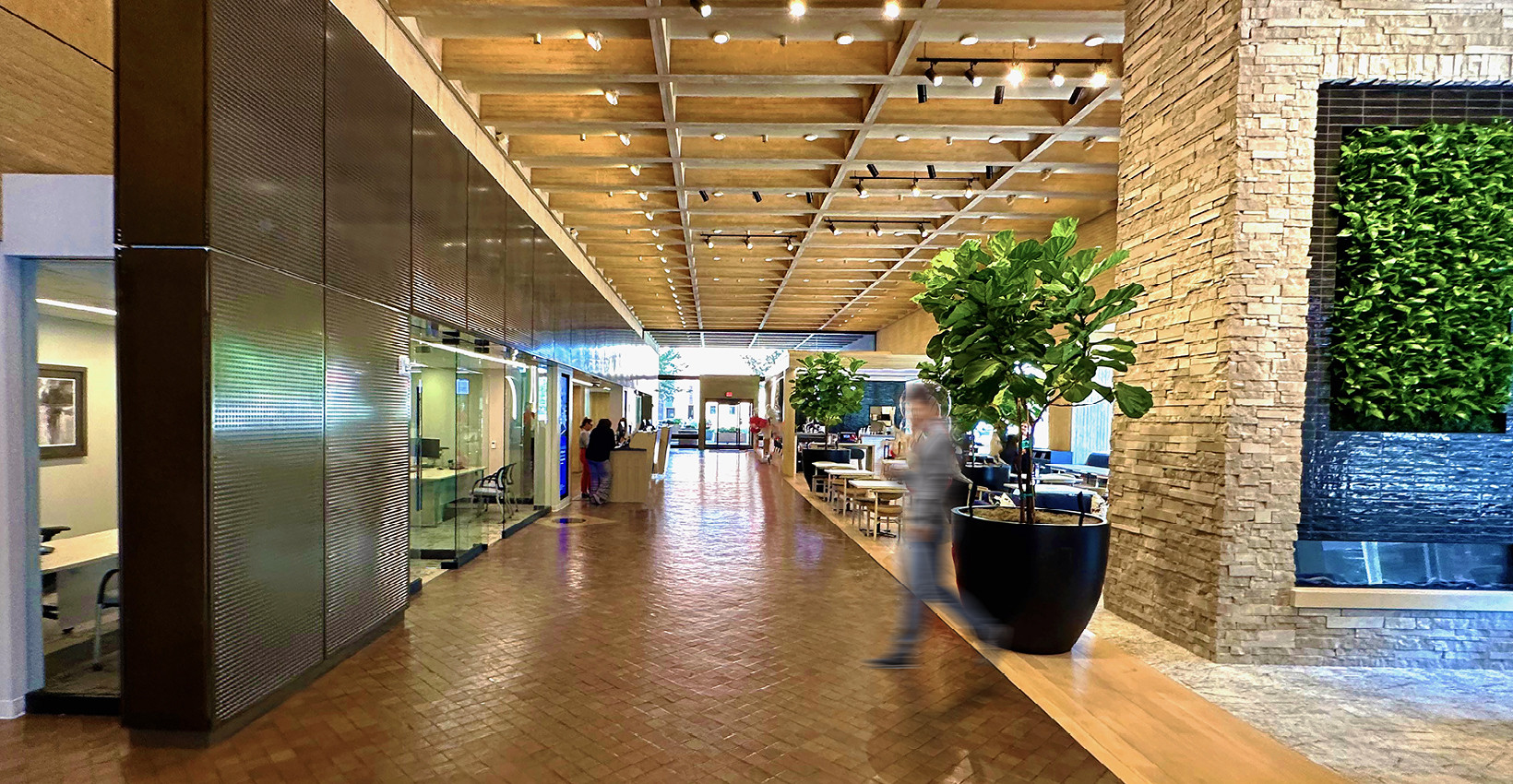Inside Union Bank Place: An interview with the architects

It’s with great excitement that UBT is opening Union Bank Place to the downtown Lincoln community. Moving our downtown branch from its former home in Nelnet’s Miller & Paine building into the historic former NBC and Wells Fargo building opened those glass doors wide to possibility. We saw the opportunity to bring more services to our customers, offer coffee from Stories Coffee Company, and pay homage to the world-renowned firm of I.M. Pei and Partners — the original designers of the buff-colored concrete structure with its subtle Nebraska shape and 93 windows, equal to the number of counties in the state. Most of all, it was an opportunity to connect with our community on a whole new level through community spaces, local pop-up retailers, and modern technology that’s suited to today’s (and tomorrow’s) banking needs.
Checking all these boxes was a tall order, and the experts from Lincoln-based design firm Sinclair Hille Architects were chosen for the task. They did not disappoint, and we recently had the opportunity to chat with Design Architect Michael Penn and Project Architect David Quade from Sinclair Hille. Their insights were so fascinating — and their enthusiasm for the project so palpable — that we just had to share.
UBT: Gentlemen, thanks for sharing your views and professional perspective.
Penn and Quade: Thanks for allowing us to contribute!
Treading lightly and honoring history
UBT: This is a building with significant local, state, and national history, given the reputation of its original designers and the unique materials from which it was made. Can you tell us how the historical value of the building design was taken into consideration, and how those historical elements influenced some of your design decisions?
Penn and Quade: From the initial discussions about the project, the view, or vision, of the design team was of an interior installation that would complement the original building but certainly be distinctly different from it. It was understood that it would be exceedingly difficult to design these new areas in a way that would be seamless to the original bank lobby. In this instance, infusing the space with quality materials but not of the same palette — such as the blond wood — was thought to be the best way to preserve and keep visible the original character of the building interior.
UBT: What were the reasons for leaving some of the signature elements unchanged: the giant Ficus Nitida, the lighting, the windows, etc.?
Penn and Quade: When working inside such an amazing space, you want to allow the beauty already there to continue to shine brightly and remain visible after you have completed the renovation work. That was the intention here, to tread lightly with the new construction and to touch as little as possible of the existing walls, ceilings, and floors.
UBT: Large branch screens weren’t being implemented in the 1970s when the space was originally designed, yet the prevalent use of technology in the new space works beautifully. Can you talk a bit about how you managed to achieve the blending of features from different decades?
Penn and Quade: The prevalence of technology and digital display is certainly a substantial change in the way banks get information out to their customers and visitors. Video is a powerful medium for all sorts of messages and purposes and is a given in most any public space today. Again, the fundamental approach to integrate this aspect into the existing interior of the building was to tread lightly and allow these technology elements to stand alone, appearing as separate and distinct from the original space.
Infusing the space with new energy
UBT: This building was, of course, originally built as the headquarters for National Bank of Commerce, who “wanted more than simply a banking facility at 13th & O. They wanted a building the entire city and state can be proud of,” according to a May 2, 1976, article in the Sunday Journal Star. It had to be exciting to know that Union Bank, as the new inhabitants of this space, echoed this sentiment and intended once again for this beautiful building to be a benefit to the community. Could you share some of your thoughts as they pertain to the public use of the space?
Penn and Quade: The street level of the building and its full public access from the north to the south has long been admired for its generosity to the public. It was exciting and gratifying to know that Union Bank wished to continue that tradition and infuse the space with new public uses and new energy. The addition of pop-up retail, a coffee shop, and collaborative meeting rooms made available to the public seems perfectly in sync with the original gesture of public access.
-------------
We are most appreciative to Michael Penn and David Quade for their time and contributions. Jason Muhleisen, UBT’s Executive Vice President, also expressed his excitement for the space and its possibilities.
“The structure started out as a bank and has remained a bank throughout. However, banks look much different than they used to, and the needs of bank customers have certainly changed. We wanted these factors to influence the functional as well as the aesthetic aspects of the interior areas, and we feel Sinclair Hille’s design team nailed it,” he says.
“The building’s original occupant, National Bank of Commerce (NBC), was another great community bank, and they really wanted the structure to be something special for downtown Lincoln, connecting Lincoln’s then-bustling retail business district to the UNL campus. That vision and community passion is in play again today, and we see Union Bank Place as a connector to UNL campus, the arts, business, and residential areas of downtown — a community hub, if you will. We are grateful to Sinclair Hille for understanding our vision and helping it come to fruition.”
We hope you enjoyed this insider’s look at Union Bank Place: melding tradition with innovation, history with possibility, and of course, commerce with community and caring. We invite our community to come see their new place!
Learning Center articles, guides, blogs, podcasts, and videos are for informational purposes only and are not an advertisement for a product or service. The accuracy and completeness is not guaranteed and does not constitute legal or tax advice. Please consult with your own tax, legal, and financial advisors.




